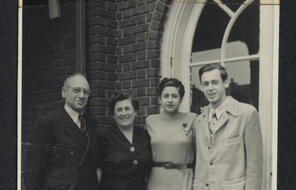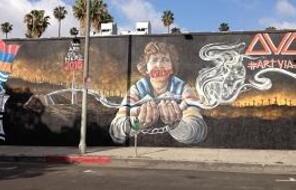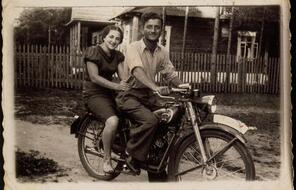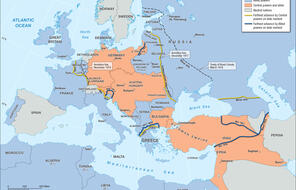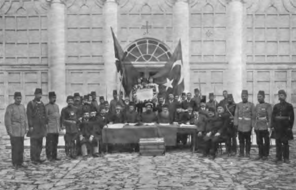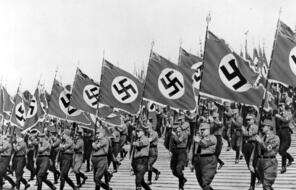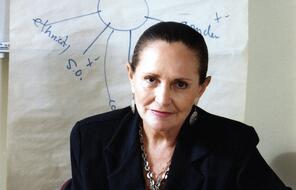Not in Our Town
At a Glance
Subject
- Civics & Citizenship
- Social Studies
- Human & Civil Rights
- The Holocaust
Not In Our Town: Billings, Montana
According to author Suzanne Goldsmith, building a community “requires only the ability to see value in others; to look at them and see a potential partner in one’s enterprise.” 1 Intolerance, hatred, and violence test the strength of a community. How the members of a community respond is one measure of its citizens' commitment to democracy. During the early 1990s, hate groups in Billings, Montana, organized a wave of racist and antisemitic violence. In 1994, journalist Claire Safran reported on the community’s response.
On a quiet evening in Billings, Montana, early [in December 1993], a stranger arrived at the home of Tammie and Brian Schnitzer. He stole across the lawn, a cinder block in hand. He stopped at a window decorated with Star of David decals and a menorah, the nine-branched candelabra that is the symbol of the Jewish festival of Chanukah. Then he hurled the stone, sending jagged shards of glass into the bedroom of Isaac, 5.
By chance, the little boy wasn’t there. He’d been in the family room watching TV with his 2-year-old sister, Rachel, and a babysitter. They heard the crash, but when the sitter searched for a cause, she missed the broken window. That remained for Brian to find when he came home. Shaken, he phoned the police and put the children to bed in the safest spot he could think of—bundled in sleeping bags under the four-poster bed in his bedroom. “We’re playing campout,” he told Isaac.
Not long after, Tammie returned from a meeting of the human rights coalition she co-chaired. Seeing the look on her husband’s face, she asked, “What’s wrong?” He led her to Isaac’s room. Shocked, she stared at the broken window. Tammie had felt a little nervous putting up the Chanukah decorations; in recent months, a string of hate crimes had occurred around town. Now her worst fears had come home.
Waiting for the police to arrive, Tammie huddled in a rocking chair in her son’s room. “I felt so cold,” she recalls. “But it wasn’t the winter air coming through the broken window. It was my sense of being so helpless. It was my fear of what would come next.”
Some 80,000 people live under the big sky of this valley town sheltered by rocky hills. They drive pickups and family sedans, dress in jeans and business suits, and mingle in an easy, relaxed way. They are overwhelmingly Christian and white; about 50 Jewish families live here, and fewer than 500 blacks. Add Hispanics and Native Americans, [and] all told, minorities in Billings make up a meager 7 percent or so of the population.
For some that’s still too many. In 1986 white supremacists declared Montana to be one of five states comprising their “Aryan homeland.” In the years that followed, racist incidents around the state became increasingly frequent; eventually they cropped up in Billings. . . .
By the end of 1992, the Knights of the Ku Klux Klan and a band of skinheads had become visible presences in Billings. Klan newspapers were tossed onto driveways, and flyers surfaced attacking mainly Jews and homosexuals. One day a bumper sticker that read “Nuke Israel” was placed on a stop sign near the temple. Not long after, Tammie saw a flyer that named Brian, who’d recently become president of the Montana association of Jewish Communities. “I felt sick,” she recalls. “It really hit home.”
At a meeting, temple officers chose not to speak out. Says Tammie, “They seemed to feel that to acknowledge a problem or identify ourselves as being different would make us stand apart.” Tammie refused to stay silent. . . .
At the same time, Margaret MacDonald . . . a mother of two and the part-time director of the Montana Association of Churches, was encountering resistance to another effort to draw attention to the problem: a petition that opposed hatred and bigotry. “There’d been an emphatic hard-line stance in the town, like a brick wall, that the less said about the skinheads and other racists, the better,” she says. She persisted, however, and over the following months, more than 100 organizations and 3,500 people signed the resolution.
In the spring of 1993, after a conversation at a town meeting, Tammie, Margaret, and several others formed the Billings Coalition for Human Rights. “This wasn’t a Jewish issue, it was a human rights issue,” says Tammie. “We wanted to make the community aware of what was going on.”
The hate activity escalated. In September, four days before the start of the Jewish New Year, vandals overturned headstones in the Jewish cemetery. And on the holiday itself, a bomb threat was made to the temple before the start of the children’s service.
Tammie urged synagogue members to speak out. “I wanted to let people know what was happening. But some members felt that we would put ourselves in more danger. We didn’t know what to do.”
In the weeks that followed, several Billings residents—inspired by the Coalition for Human Rights—took action against racism. When skinheads showed up at services of the African Methodist Episcopal Wayman Chapel, small groups of white Christians appeared in response. They sat with the congregation until the skinheads stopped coming. In October an interracial couple awoke one morning to find crude words and a swastika spray-painted on their house. Three days later, volunteers from the local painters union repaired the damage.
But with the arrival of the holiday season, the hate incidents turned violent. In late November a beer bottle was thrown through the window of a Jewish home. And then, on the night of December 2, the Schnitzer home was attacked.
As Tammie spoke with the police officer who’d arrived at her home, she swung between fear and outrage. “This isn’t just mischief,” she said. He agreed and advised her to take down the Chanukah decorations and avoid leaving the children with a babysitter.
Lying in bed that night, sleepless, Tammie thought how ironic it was that the attack on her home had occurred because of Chanukah—a holiday commemorating the Jews’ fight thousands of years ago to worship God in their own way. “I wondered what kind of struggle we were going to be in for, and how we could stop it before it became worse,” she says.
The next day, Friday, Tammie spoke with a reporter from the Billings Gazette. She told him how troubled she was by the officer’s advice. “Maybe it’s not wise to keep these symbols up,” she said. “But how do you explain that to a child?”
On Saturday morning Margaret [MacDonald] read Tammie’s quote in the paper. She tried to imagine telling her daughter, Siri, then 6, that they could not have a Christmas tree, or explaining to Charlie, then 3, that they had to take a wreath off the door because it wasn’t safe.
Margaret phoned her pastor, Keith Torney. “What would you think if we had the children draw menorahs in Sunday school?” she asked. “If we mimeographed as many pictures of the menorah as we could? If we told people to put them up in their windows?”
Reverend Torney had read the paper that morning too. “Yes,” he said. “And yes again.” He spent the rest of the day on the phone, enlisting other churches. That week hundreds of menorahs appeared in the windows of Christian homes in Billings. “It wasn’t an easy decision,” says Margaret. “With two young children, I had to think hard about it myself. We put our menorah in a living room window, and made sure nobody sat in front of it.”
One of the first to put up a menorah was Becky Thomas, . . . a Catholic mother of two who lives near the Schnitzers. “It’s easy to go around saying you support some good cause, but this was different. It was putting ourselves in danger,” she says. “I told my husband, ‘Now we know how the Schnitzers feel.’”
Some, nervous about jeopardizing their families, checked first with Wayne Inman, the chief of police at the time. “Yes, there’s a risk,” he told callers. “But there’s a greater risk in not doing it.”
On December 7, the Billings Gazette published a full-page picture of a menorah to cut out and tape up. Local businesses also distributed photocopies of menorahs, and one put a message on a billboard, proclaiming: “Not in Our Town! No Hate, No Violence. Peace on Earth.”
As the Jewish symbol sprouted in Christian windows, the haters lashed out. Glass panes on the doors of the Evangelical United Methodist Church, graced with two menorahs, were smashed. Someone fired shots into a Catholic school that had joined the crusade. Six cars parked in front of homes that displayed menorahs had their windows kicked out; the homeowners received phone calls that told them to “Go look at your car, Jew-lover.”
Yet suddenly, for every menorah that was there before, ten new ones appeared. Hundreds of menorahs grew to be thousands. It’s estimated that as many as 6,000 homes in Billings had menorahs on display. “All along, our coalition had been saying an attack on one of us is an attack on all of us,” says Margaret MacDonald. “And God bless them, the people of this town understood.” . . .
The people of Billings kept their menorahs up until the New Year. As Inman says, “The haters could attack a couple of Jewish homes. They could make a second wave of attacks on Christian homes and churches. But they could not target thousands of menorahs.”
Confronted by a united town, the Ku Klux Klan and skinheads backed off. The acts of vandalism stopped, the hate literature disappeared, and the anonymous calls ended. But with no witnesses and no strong leads, the police were never able to make any arrests, a fact that leaves the community extremely uneasy. . . .
The town continues to stand together. In April [of 1994] more than 250 Christians joined the Jewish community for a seder, the traditional Passover meal. Not long after, hundreds attended a concert of Jewish music that the Schnitzers helped coordinate to show their appreciation to Billings.
Tammie Schnitzer and Margaret MacDonald are busy organizing meetings and speaking at schools about racial sensitivity. With Chanukah just a few weeks away, they’re stepping up their activities and are working on combined holiday events for the temple and local churches.
Soon Tammie’s going to be putting up her Chanukah decorations. “I have to make sure my kids are proud of themselves and never have to hide who they are,” she says. “Yes, I’m afraid. But I know if something happened again, the community would respond.”
Becky Thomas, for one, is prepared. “We saved our menorah, and it’s going in our window again,” she says. “We need to show commitment for a lifetime.” 2
Roger Rosenblatt of the New York Times interviewed Billings residents in 1994 and found that many of them were reassessing their attitudes and beliefs as a result of the menorah campaign. Wayne Inman, former Billings chief of police, told Rosenblatt that although there had been no African Americans or Jews in his hometown, he grew up hearing racial slurs.
It was as common as the sun coming up in the morning. Nobody ever confronted the issue. It was “normal.” But when I got out into the larger world, I found that it wasn’t normal, or if it was normal, it should be opposed. When you have a person present, not just a word, you see that you’re talking about a human being whose skin is black. I saw that for myself. I saw the hurt and pain in his eyes. It became a very personal issue for me. 3
Sarah Anthony, a member of the Human Rights Coalition, reflected on the struggle and why it matters to her. She told Rosenblatt:
I mean, what have we done so far? Come up with a plan. Make a few phone calls. Put up menorahs. That’s all we did. Pretty simple stuff, actually. But you have to build the sentiment, to forge the real feeling that goes deep. We did something right here, and we will do it again if we have to. If we don’t, there are people who would break every window in Billings, and we would look out those windows and see ourselves. 4
Connection Questions
- How did racism and antisemitism test the strength of the Billings community? What did the citizens' response reveal about their universe of obligation? How was their response related to their commitment to democracy?
- What does the story of Billings suggest about the way people can get involved? What does it suggest about the way one act leads to another and yet another? What precedents or past actions did the people of Billings build on? What legacies did they leave for their children? For other communities?
- What does Sarah Anthony mean when she says, "We did something right here, and we will do it again if we have to. If we don't, there are people who would break every window in Billings, and we would look out those windows and see ourselves"? Activist Marian Wright Edelman believes that "the good people's silence" can be "as damaging as the bad people's actions." Would Anthony agree? Do you agree?
- What is a hate crime? What distinguishes a hate crime from other crimes? After a rock was thrown through the window of a home that belonged to a Vietnamese family, then Deputy Superintendent William Johnston of the Boston Police Department noted that the rock did more than shatter glass. It also shattered a family. What do you think he might have meant? How do his words apply to the situation in Billings that you read about?
- "Hate crimes are not a police problem," says former Police Chief Wayne Inman. "They're a community problem. Hate crimes and hate activity flourish only in communities that allow them to flourish." James Pace, the head of a racist "skinhead" group in Billings, agrees. He told a reporter, "If you have a racist problem, it was here and it's been here and it's going to be here if we are here or not." Why do you think people join hate groups? What can people do to make sure that hate groups do not flourish in their communities?
- 1Suzanne Goldsmith-Hirsch, A City Year: On the Streets and in the Neighborhoods with Twelve Young Community Service Volunteers (New Brunswick, N.J., U.S.A: Transaction Publishers, 1998), 277.
- 2Claire Safran, “Not in Our Town,” Redbook, November 1994. Reprinted by permission from Scott Williams, on behalf of the Estate of Claire Safran Williams.
- 3Roger Rosenblatt, “Their Finest Minute,” New York Times, July 3, 1994.
- 4Roger Rosenblatt, “Their Finest Minute,” New York Times, July 3, 1994.
Get the Handout
How to Cite This Reading
Facing History & Ourselves, "Not in Our Town," last updated August 2, 2016.





